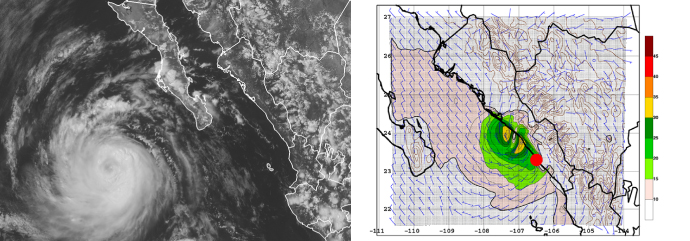Landfalling tropical cyclones in the Eastern Pacific basin (SGP-CRA 2048)

1) A visible satellite image of Hurricane Ileana from 2012, close to the Baja Peninsula.
2) Simulations of Hurricane Rick (2009) as it makes landfall. The red dot marks the actual landfall, while the blue dot marks the predicted landfall location using HWRF. The colors indicate the pattern of the magnitude of the wind at the surface and the blue arrows show the wind direction. The brown contour lines indicate the topography.
Project information
Universidad Nacional Autónoma de México (UNAM) – Centro de Ciencias de la Atmósfera
This project follows the research started in CRN 2048, with the same title.
Executive summary
The Eastern Pacific has the highest density of tropical cyclones worldwide, and upon landfall they often produce catastrophic rains, flooding and landslides. The Mexican Meteorological Service (SMN) and the US National Hurricane Center (NHC) issue intensity forecasts for active cyclones, which help emergency managers to prepare warnings to the public, but accuracy and reliability need to be improved for more effective disaster prevention.
Goals
To increase the length of the reconstructed historical record of landfalling cyclones to cover the period from 1500 to the present.
To investigate the hypothesis that lightning in hurricanes is a function of the type of cloud condensation nuclei (maritime versus continental) and a proxy for intensification (especially before landfall).
To incorporate a modeling component with high-resolution ocean models to more accurately predict the storm surge associated with approaching cyclones.
To include an atmospheric model (HWRF) to improve track forecasts, to transfer practical knowledge and experience to the operational personnel at SMN.
To provide a training course to improve the human resources in the topic of tropical cyclones.
First results
The historical reconstruction back to 1750 has proven much more difficult. The results may not be useful from a climatological viewpoint, but are very worthy as anthropological/historical research.
The spatial distribution of lightning is different between cyclones that have mostly westward tracks (lower rates and more in the inner core, within 100 km of radius) than the ones with trajectories that re-curve and make landfall in the mainland. Cyclones in the latter category show more lightning in the outer bands (between 300 and 400 km from the eye) and in the quadrant closer to land.
Moreover, the spatial distribution of lightning does not appear to be organized by the shear vector, as has been shown for cyclones in the North Atlantic basin.
Preliminary simulations with the HWRF model at 3-km resolution indicate that there are still large track and intensity errors, as well as for the landfall location along the coast that need to be quantified.
Project investigators
Graciela Binimelis de Raga (graciela.raga@gmail.com)
Universidad Nacional Autónoma de México (UNAM) – Centro de Ciencias de la Atmósfera
Co-Investigators
Luis M. Farfán Molina (CICESE, Mexico)
Christian Appendini (IINGEN-UNAM, Mexico)
Virginia García-Acosta (CIESAS, Mexico)
Raymundo Padilla Lozoya (Universidad de Colima, Mexico)
Julio Marín (Universidad de Valparaiso, Chile)
Sergio Abarca (Naval Posgraduate School, USA)
Victor Rivera-Monroy (Lousiana State University, USA)
Joel Pérez (CATHALAC, Panama)
Co-Investigators
Luis M. Farfán Molina (CICESE, Mexico)Christian Appendini (IINGEN-UNAM, Mexico)
Virginia García-Acosta (CIESAS, Mexico)
Raymundo Padilla Lozoya (Universidad de Colima, Mexico)
Julio Marín (Universidad de Valparaiso, Chile)
Sergio Abarca (Naval Posgraduate School, USA)
Victor Rivera-Monroy (Lousiana State University, USA)
Joel Pérez (CATHALAC, Panama)
Students
Adolfo Lugo, Master, Universidad Nacional Autónoma de Mexico, Mexico.
Cuauhtemoc Turrent, Post Doctorate, CICESE, Mexico.
Ismael Villanueva, Master, CICESE, Mexico.
Jimena Cuevas, Master, CICESE, Mexico.
Jorge Clouthier, Master, Universidad Nacional Autónoma de Mexico, Mexico.
Jose Vicencio, Other, Universidad de Valparaiso, Chile.
Juan Sebastian Cervantes, PHD, Universidad Nacional Autónoma de Mexico, Mexico.
Lourdes Aquino, Master, Universidad Nacional Autónoma de Mexico, Mexico.
Myriam de la Parra, Master, CIESAS, Mexico.
Rafael Meza, PHD, Universidad Nacional Autónoma de Mexico, Mexico.
Thalia Aviles, PHD, Universidad Nacional Autónoma de Mexico, Mexico.
PDF in English PDF in Spanish updated 4/2013
